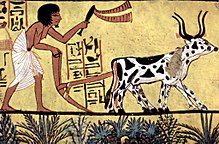
Back آرو Arabic Aaru AST Іару Byelorussian Аару Bulgarian Aaru Catalan Aaru Danish Sechet-iaru German Aaru Spanish آرو (مصر) Persian Champs d'Ialou French
art]], from Dayr al-Madīnah.]]
Aaru (/ɑːˈruː/; Ancient Egyptian: jꜣrw, lit. 'reeds'), or the Field of Reeds (sḫt-jꜣrw, sekhet-aaru), is the name for heavenly paradise in Egyptian mythology. Ruled over by Osiris, an Egyptian god, the location has been described as the ka of the Nile Delta.
Ancient Egyptians believed that the soul resided in the heart, and that each individual would therefore undergo a "Weighing of the Heart" in the afterlife; each human heart is weighed on a giant scale against an ostrich feather, which represents the concept of the goddess Maat. All souls that successfully balance the scales will be allowed to start a long and perilous journey to Aaru, where they will exist in peace and pleasure for eternity. Conversely, hearts that are heavy with evil will tumble from the scale pan and fall into the crocodilian jaws of the goddess Ammit. Any souls that are subject to Ammit's "second death" are doomed to restlessness in the Duat.[1]


Qualifying souls undergo a long journey and face many perils before finally reaching Aaru. Once they arrive, they enter through a series of gates — the exact number of gates varies across sources, with given figures alternating between 15 gates and 21 gates. They are uniformly described as being guarded by deities and evil demons, and if the deceased passed through these final gates, they would be rowed across the water to the shores of the Field of Reeds.[2]
Aaru was usually placed in the east, where the Sun rises, and has been described as comprising boundless reed fields, like those of the Nile Delta. Consequently, this ideal hunting and farming ground enabled qualified souls to live for eternity; more precisely, Aaru was envisaged as a series of islands covered in fields of reeds. The part where Osiris later dwelt is sometimes known as the "field of offerings" (sḫt-ḥtpt).
- ^ Fadl, Ayman. "Egyptian Heaven". Article. Aldokkan. Retrieved 15 March 2012.
- ^ Mark, Joshua J. "Field of Reeds (Aaru)". World History Encyclopedia. Retrieved 20 March 2023.
© MMXXIII Rich X Search. We shall prevail. All rights reserved. Rich X Search